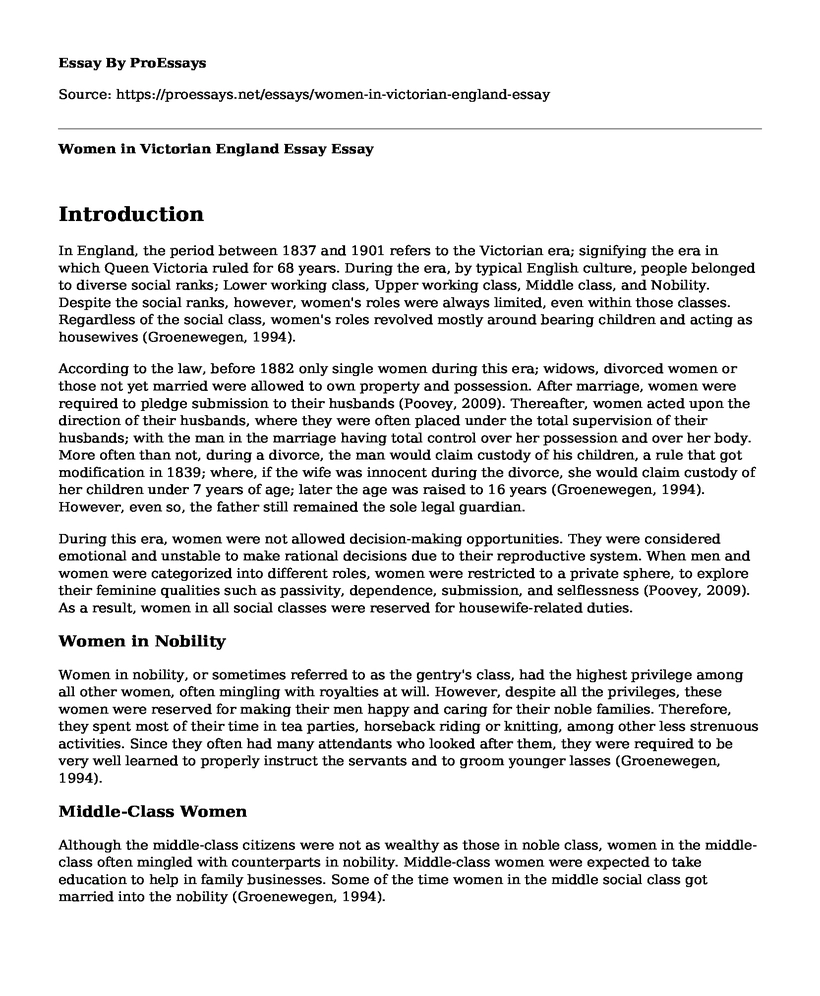Introduction
In England, the period between 1837 and 1901 refers to the Victorian era; signifying the era in which Queen Victoria ruled for 68 years. During the era, by typical English culture, people belonged to diverse social ranks; Lower working class, Upper working class, Middle class, and Nobility. Despite the social ranks, however, women's roles were always limited, even within those classes. Regardless of the social class, women's roles revolved mostly around bearing children and acting as housewives (Groenewegen, 1994).
According to the law, before 1882 only single women during this era; widows, divorced women or those not yet married were allowed to own property and possession. After marriage, women were required to pledge submission to their husbands (Poovey, 2009). Thereafter, women acted upon the direction of their husbands, where they were often placed under the total supervision of their husbands; with the man in the marriage having total control over her possession and over her body. More often than not, during a divorce, the man would claim custody of his children, a rule that got modification in 1839; where, if the wife was innocent during the divorce, she would claim custody of her children under 7 years of age; later the age was raised to 16 years (Groenewegen, 1994). However, even so, the father still remained the sole legal guardian.
During this era, women were not allowed decision-making opportunities. They were considered emotional and unstable to make rational decisions due to their reproductive system. When men and women were categorized into different roles, women were restricted to a private sphere, to explore their feminine qualities such as passivity, dependence, submission, and selflessness (Poovey, 2009). As a result, women in all social classes were reserved for housewife-related duties.
Women in Nobility
Women in nobility, or sometimes referred to as the gentry's class, had the highest privilege among all other women, often mingling with royalties at will. However, despite all the privileges, these women were reserved for making their men happy and caring for their noble families. Therefore, they spent most of their time in tea parties, horseback riding or knitting, among other less strenuous activities. Since they often had many attendants who looked after them, they were required to be very well learned to properly instruct the servants and to groom younger lasses (Groenewegen, 1994).
Middle-Class Women
Although the middle-class citizens were not as wealthy as those in noble class, women in the middle-class often mingled with counterparts in nobility. Middle-class women were expected to take education to help in family businesses. Some of the time women in the middle social class got married into the nobility (Groenewegen, 1994).
Women in Working Class
The upper class was divided into two; the lower and upper working ranks. Women in the upper rank often tried a variety of jobs; working as a governess, schoolmistresses or housekeepers, among other decent jobs. Lower working class women, on the other hand, participated in jobs like being tradeswomen; selling goods to people in their villages, or as upper-middle-class women's housekeepers (Groenewegen, 1994).
Lower-Class Women
Women in the lower classes often came from extreme poverty. More often than not, women in the lower class took menial jobs; working as prostitutes or laborers. Their jobs often involved physical exertion. Lower class women often remained single most of their lives; women outnumbered men in these low-class neighborhoods (Groenewegen, 1994).
Conclusion
In conclusion, women throughout the Victorian era were often treated as secondary citizens to their male counterparts. As a result, they were only expected to concern themselves with keeping their households successful; bearing children and submitting to their husbands.
References
Groenewegen, P. (1994). Feminism and political economy in Victorian England. Edward Elgar Publishing.
Poovey, M. (2009). Uneven developments: The ideological work of gender in mid-Victorian England. University of Chicago Press.
Cite this page
Women in Victorian England Essay. (2022, Jul 20). Retrieved from https://proessays.net/essays/women-in-victorian-england-essay
If you are the original author of this essay and no longer wish to have it published on the ProEssays website, please click below to request its removal:
- Essay Sample on de Beauvoir's Hope for Women
- Essay Sample on Black Identities
- Military Personnel Make Great Assets in the Business World Essay Example
- Essay Example on Native Americans in Z Nation: Misrepresentation and Stereotypes
- U.S. Marijuana Use: Federal vs. State Laws - Research Paper
- Essay on Early Prenatal Care Access for Mexican-American Women: Challenges & Solutions
- Essay Example on Black Americans: A History of Oppression and Resistance







